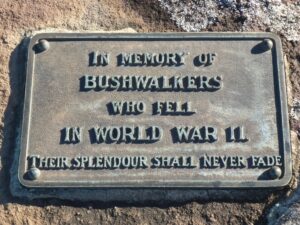Where were you on November 11, 2019?
On November 10 a good bushwalking friend, Matthew Stephenson and I had camped on Mt Dingo for November 11. We were at Splendour Rock to remember the end of World War One 100 years ago.
On November 11, 1918, the guns of World War I fell silent. Each year since then Australia falls silent for one minute at 11am (as the eleventh hour of the eleventh day of the eleventh month). The mass slaughter was over, but the war was not over until the Treaty of Versailles was signed on 28 June 1919. Medals from World War I often call it “The Great War 1914 – 1919”. It had been such a vast war that it was thought this was “the war to end wars”.
The First AIF (Australian Imperial Force) army under General Sir John Monash played an important role in pushing the German army back to the border of Germany. In the ‘glorious 100 days’ of combat Monash and the allies used the “all arms combat” they had developed where artillery, infantry, tanks, and planes all worked together. The way was open to Berlin, but the allies went no further. The German people were close to a (possible communist) revolution from a food blockage by the Royal Navy. The German Navy had tried to stop convoys getting to Britain with submarine warfare, but the Royal Navy was successful in its similar blockade. The Australian Light Horse had also played a major role in the defeat of the Ottoman (Turk) empire in 1918. The original ANZAC Day Gallipoli campaign of 1915 was an attempt to defeat the Turks through the Dardanelles.
Unfortunately, there were those like Adolf Hitler who were convinced that Germany had not truly been defeated and hence wanted another go. Japan had been an ally in WWI but felt slighted by the terms of The Treaty of Versailles.
War came close to Australia in New Guinea during WWII. Darwin, Broome, and many other northern Australian towns were bombed. Around 191 bushwalkers (young men and women) from clubs of Bushwalking NSW (BNSW) joined the fight. Seven died in the Pacific Campaign while six others died in the European theatre.
Post WWII bushwalkers of BNSW were hurting. They were keen not to forget these thirteen bushwalkers as their numbers had included some outstanding bushwalkers.
Several ideas were thrown around including a memorial park on Narrow Neck or renaming a peak towards Kanangra Walls. Now, Splendour Rock had always been a special location. It is even featured in ‘An Introduction to Bush Walking’ from 1939.
During February of 1948 four bushwalkers installed the memorial plaque at Splendour Rock. In the book by Michael Keats and I (Splendour Rock – A Bushwalkers War Memorial) you can see the breakdown of which items each bushwalker carried as described from Minutes of BNSW.
We are not sure of how many bushwalkers were present at the dedication of Splendour Rock on ANZAC Day 1948. It was led by Paddy Pallin (an RAF veteran from WWI) and the BNSW President, Stan Cottier. It is said a list was passed around, but I have never seen it. One report says 140 bushwalkers while another suggests 80 bushwalkers were present. Equally, I have not seen a list of the bushwalkers who served despite having a Bushwalkers Services Committee to support bushwalkers on service. The list of 191 bushwalkers in our book is based on a collation of data from available sources.
Australia changed considerably as it fought for its survival. It changed from an agricultural society to an industrial society. In WWI only Australia and India were volunteer armies. Very few women served, mainly as nurses. In WWII women donned overalls to work in factories or served in important support roles within many auxiliary services. Male farm labour was replaced by the Australian Women’s Land Army (AWLA). While two Conscription referendums had been defeated in WWI under the (WWII) Manpower Regulations the entire Australian workforce was either directed into armed services or kept at home (like my father) for essential services to make munitions or war materials. Rationing was tight. At the end of WWII Australia had the fourth largest air force in the world. So many of the very best young bushwalkers were serving that there was concern about the future of bushwalking.
Only since 1992 has there been an annual ANZAC Day Dawn Service at Splendour Rock. Australia’s most remote war memorial requires a serious bushwalk to get there so for many past mid-week ANZAC Days there was no service. Special anniversaries only had been remembered.
An overnight camp on Mt Dingo then the Dawn Service on ANZAC Day is a never-to-be forgotten experience especially the sunrise over King’s Tableland. All bushwalkers should go there at least once. Splendour Rock has drawn visitors from all over the world.
Matthew and I were on our own on November 11, 2019, but we did not stay until 11am. The bushfires of the ‘Black Summer’ were already becoming a menace. Walking in the Wild Dogs during midday was out of the question as it was going to be a fiercely hot day. We passed through the upper gate in the Megalong Valley just as an NP&WS Ranger was posting a sign – PARK CLOSED.
Keith Maxwell.

The Splendour Rock plaque from 1948.

Comments are closed.